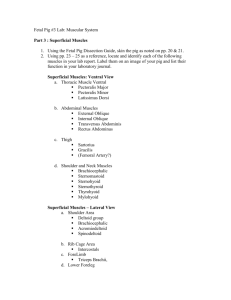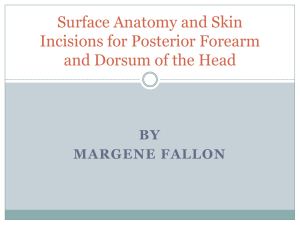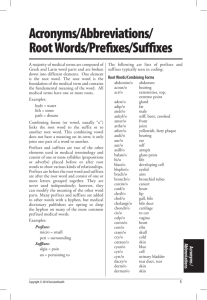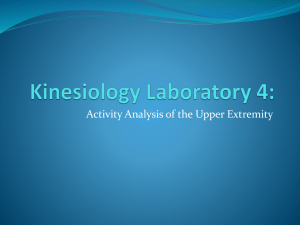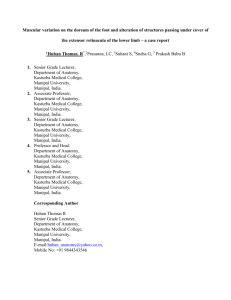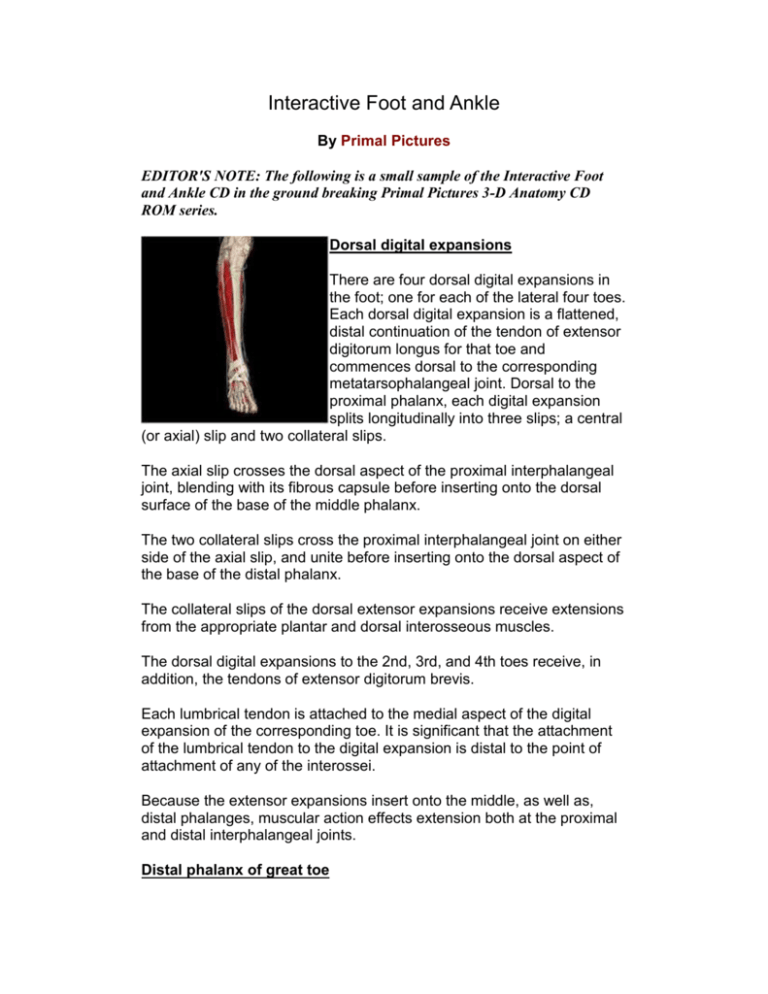
Interactive Foot and Ankle
By Primal Pictures
EDITOR'S NOTE: The following is a small sample of the Interactive Foot
and Ankle CD in the ground breaking Primal Pictures 3-D Anatomy CD
ROM series.
Dorsal digital expansions
There are four dorsal digital expansions in
the foot; one for each of the lateral four toes.
Each dorsal digital expansion is a flattened,
distal continuation of the tendon of extensor
digitorum longus for that toe and
commences dorsal to the corresponding
metatarsophalangeal joint. Dorsal to the
proximal phalanx, each digital expansion
splits longitudinally into three slips; a central
(or axial) slip and two collateral slips.
The axial slip crosses the dorsal aspect of the proximal interphalangeal
joint, blending with its fibrous capsule before inserting onto the dorsal
surface of the base of the middle phalanx.
The two collateral slips cross the proximal interphalangeal joint on either
side of the axial slip, and unite before inserting onto the dorsal aspect of
the base of the distal phalanx.
The collateral slips of the dorsal extensor expansions receive extensions
from the appropriate plantar and dorsal interosseous muscles.
The dorsal digital expansions to the 2nd, 3rd, and 4th toes receive, in
addition, the tendons of extensor digitorum brevis.
Each lumbrical tendon is attached to the medial aspect of the digital
expansion of the corresponding toe. It is significant that the attachment
of the lumbrical tendon to the digital expansion is distal to the point of
attachment of any of the interossei.
Because the extensor expansions insert onto the middle, as well as,
distal phalanges, muscular action effects extension both at the proximal
and distal interphalangeal joints.
Distal phalanx of great toe
It is a miniature long bone and comprises a base proximally, a head
distally, and an intervening shaft. The base of the distal phalanx of the
hallux articulates with the head of the proximal phalanx. The dorsal
aspect of the base of the distal phalanx receives the insertion of the
tendon of extensor hallucis longus, while the plantar aspect of the base
receives the insertion of the tendon of flexor hallucis longus. Tubercles
on either side of the base provide attachment for the collateral ligaments
of the interphalangeal joint
Extensor digitorum longus
Proximal attachment
Proximally, the extensor digitorum longus
arises contiguously from the inferior aspect
of lateral tibial condyle, upper three-fourths
of the medial (extensor) surface of fibula,
anterior surface of interosseous membrane,
anterior intermuscular septum, and from the
overlying deep fascia.
Distal attachment
The extensor digitorum longus muscle becomes tendinous in the distal
part of the leg. The tendon passes over the anterior aspect of the ankle
joint lateral to the tendon of extensor hallucis longus. The tendon of
extensor digitorum longus then splits into four slips beneath the inferior
extensor retinaculum. The four slips (one for each of the lateral four
toes) diverge on the dorsum of the foot and insert onto the dorsal
aspects of the middle and distal phalanges of the corresponding toes,
via the dorsal digital expansions.
Nerve supply
Deep peroneal nerve (L4, L5 and S1)
Action
Extensor digitorum longus, extends the lateral four toes at the
interphalangeal and metatarsophalangeal joints and assists in
dorsiflexion of the ankle.
Extensor digitorum brevis
Extensor digitorum brevis is an intrinsic muscle of the foot, and the only
one to be situated on the dorsum of the foot. It lies deep to the tendons
of extensor digitorum longus. The belly of the muscle can be palpated
inferomedial to the lateral malleolus on the dorsum of the foot
Proximal attachment
Proximally, extensor digitorum brevis originates from the anterolateral
part of the upper surface of the calcaneus and contiguously from an
adjacent area on the lateral calcaneal surface. The muscle also takes
attachment from the stem of the inferior extensor retinaculum which
overlies it.
Distal attachment
From its origin, the muscle runs in a distomedial direction on the dorsum
of the foot, and gives rise to four tendons; one for each of the medial four
toes. The most medial of the four tendons is that of extensor hallucis
brevis; it attaches to the dorsal aspect of the base of the proximal
phalanx of the hallux. The next three tendons attach, in sequence, to the
lateral aspects of the extensor digitorum longus tendons to the 2nd, 3rd,
and 4th toes.
Nerve supply
Deep peroneal (L5 and S1).
Action
Assists extensor hallucis longus in dorsiflexion of the hallux at the
proximal interphalangeal joint, and assists extensor digitorum longus in
dorsiflexing the 2nd, 3rd, and 4th toes .
Intermediate cuneiform
The smallest of three wedge-shaped bones which lie between the distal
aspect of the navicular and the medial three metatarsals. It articulates
with the navicular proximally, and with the base of the 2nd metatarsal
distally. In addition, it articulates with the medial cuneiform medially and
the lateral cuneiform laterally. It is wide and square on its dorsal surface
and narrow on its plantar aspect. The dorsal and plantar aspects are
roughened for the attachments of a number of interosseous ligaments.
The plantar surface receives a small slip of insertion of tibialis posterior
and gives attachment to part of the origin of
flexor hallucis brevis.
Calcaneus
The calcaneus is the largest and most plantar of the tarsal bones and
forms the heel of the foot . It is an irregularly cuboidal bone presenting
six surfaces: the superior surface articulates with the talus ; the distal
surface articulates with the cuboid ; the medial surface has a shelf-like
projection called the sustentaculum tali, which supports the head of the
talus; the lateral surface features the peroneal trochlea which separates
the tendons of peroneus longus and brevis; the posterior surface
receives the tendo calcaneus; the inferior surface is roughened
posteriorly and forms the major weightbearing area of the calcaneus.
This surface provides attachment for the plantar aponeurosis, several
plantar muscles and ligaments.
The calcaneus articulates with the cuboid and talus, and embryologically
forms the posterior part of the lateral column of the foot. It is often
fractured by direct vertical force, as when landing on the heel in a fall
from a height. When the calcaneus is fractured in this manner, there is a
loss of height of the bone, broadening of the heel, and there are classical
intra-articular fracture patterns. Radiologically, Bohler's angle is
markedly decreased and may, in some instances, be reversed.
Calcaneus: superior surface
The upper surface of the calcaneus presents three
articular facets as follows:
a. Occupying the middle third of the upper
surface of the calcaneus is the posterior talar
facet. This is an oval, smooth and convex facet
with its long axis running obliquely in a
distolateral direction. It engages a reciprocally
concave facet on the inferior surface of the talar
body to form the subtalar talocalcaneal joint.
b. Anteromedial to the posterior articular facet and occupying the entire upper
surface of the sustentaculum tali is an elongated and concave facet, also with its
long axis running in a distolateral direction. This is the middle talar facet.
It is part of the talocalcaneonavicular joint, and engages the inferomedial aspect
of the talar head.
c. Immediately anterolateral to the middle talar facet, and often confluent with
it, is the anterior talar facet. It is part of the talocalcaneonavicular joint, and
engages the inferolateral aspect of the talar head.
Situated on the upper surface of the calcaneus, in front of the posterior talar
facet and behind the middle and anterior talar facets, is the sulcus calcanei, an
obliquely disposed groove. The sulcus calcanei gives attachment to the
interosseous talocalcaneal ligament.
The upper surface of the calcaneus, anterior to the lateral end of the sulcus
calcanei, gives attachment to the cervical ligament, bifurcate ligament, the
origin of extensor digitorum brevis, and the stem of the inferior extensor
retinaculum.
Behind the posterior talar facet, on the upper surface of the calcaneus, is a
somewhat rough, non-articular area which is covered by fibrous and adipose
tissue and represents the interval between the tendo calcaneus posteriorly and
the ankle joint anteriorly.
CLICK HERE for more information on the Primal Pictures 3-D Anatomy
series and for details on exclusive PTontheNET.com member discounts
Disclaimer
No warranty is given as to the accuracy of the information on any of the pages in this website. No responsibility is accepted for
any loss or damage suffered as a result of the use of that information or reliance on it. It is a matter for users to satisfy themselves
as to their or their client’s medical and physical condition to adopt the information or recommendations made. Notwithstanding a
users medical or physical condition, no responsibility or liability is accepted for any loss or damage suffered by any person as a
result of adopting the information or recommendations.
© Copyright Personal Training on the Net 1998 2003 All rights reserved

